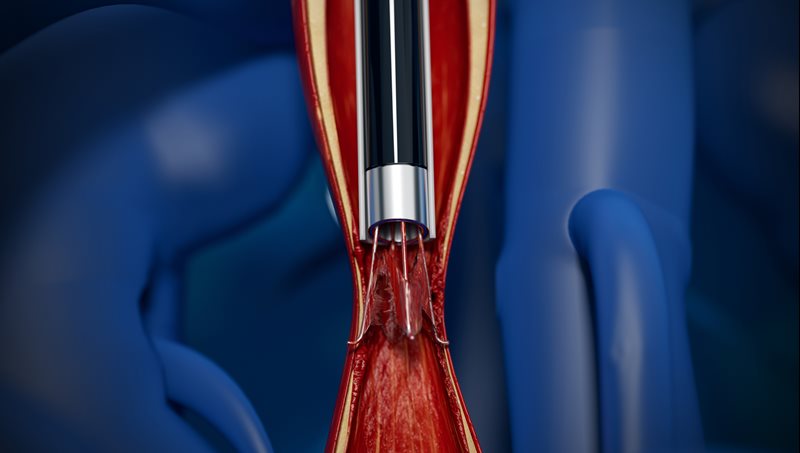Minimally Invasive IVC Filter Removal Successful in First Patients
 The first patients have been successfully treated for Inferior Vena Cava (IVC) filter removal using Royal Philips’ IVC Filter Removal Laser Sheath – CavaClear, according to a company announcement.
The first patients have been successfully treated for Inferior Vena Cava (IVC) filter removal using Royal Philips’ IVC Filter Removal Laser Sheath – CavaClear, according to a company announcement.
CavaClear provides an effective, minimally invasive solution for embedded IVC filters, to help physicians reduce risk of significant filter-related complications in patients and improve workflow performance. The first two patients were successfully treated at Northwestern Medicine (Chicago, IL) by Kush R. Desai, MD, FSIR, Associate Professor of Radiology, Surgery, and Medicine, and Director of Deep Venous Interventions, Division of Interventional Radiology at Northwestern University Feinberg School of Medicine, and at Stanford Hospital (Palo Alto, CA) by William T. Kuo, MD, FSIR, FCCP, FSVM, FACR, FCIRSE, Professor of Interventional Radiology and Director of the Stanford IVC Filter Clinic at Stanford University School of Medicine.
IVC filters are used to treat patients with venous thromboembolism, in which blood clots form in the deep veins of the leg and groin and can travel through the circulatory system. They are placed in the inferior vena cava to capture blood clots from moving to the lungs. However, research has shown that IVC filters may have long-term complications. The filters can fracture and travel through the bloodstream to other parts of the body. Other identified long-term risks associated with IVC filters include penetration into adjacent organs and IVC occlusion. The FDA recommends that implanting physicians consider removing retrievable IVC filters as soon as they are no longer indicated.
CavaClear uses circumferential tissue ablation to aid in capturing the filter within seconds of laser activation, which can help increase procedural efficiency during removal and may help lower costs by reducing the number of retrieval attempts needed to remove an embedded filter. In addition, the simple and safe design is easy for physicians to integrate into their workflow and reduce the need for high-force retrievals that could increase the chance of a complication.
“Millions of patients have IVC filters that are no longer indicated, and CavaClear helps physicians experienced in IVC filter retrieval work towards the goal of safely removing such devices, in line with regulatory guidance,” said Dr. Desai.
Dr. Desai treated the first patient with CavaClear at Northwestern Medicine by removing an IVC filter that was placed over 6 months prior for deep vein thromboembolism. An attempt to retrieve the filter was made approximately 4 months post implant at another institution, however, the procedure was unsuccessful and then referred to Dr. Desai. CavaClear was later successfully applied to quickly and safely free the embedded filter from the caval wall, enabling the patient to now be filter-free.
At Stanford Hospital, Dr. Kuo performed the first CavaClear retrieval on a chronically embedded IVC filter that was placed more than 16 years ago. The filter was rediscovered after the patient developed lifestyle-limiting pain and blood vessel occlusions related to the filter. Due to case complexity, none of the patient’s original physicians outside of the USA were able to provide a safe treatment plan and so referred the patient to the Stanford IVC Filter Clinic.
The patient commented on his experience, “I am so thankful to Dr. Kuo and the team for accepting me as a patient when none of my doctors back home would even attempt removal of my 16-year-old IVC filter, which was causing painful penetration and blood vessel blockage requiring blood thinners. The worst thing is that I was previously a cyclist and sportsman who used to ride more than 7000 miles per year, but after these blockages, I became so weak that I could not even climb the stairs of my home. I now look forward to exercising again. I want to thank all members of the team involved. I will never get tired of saying thank you!”
“We chose to use CavaClear on a chronic filter implant that was embedded for over 16 years and completely encased in scar tissue. Prior to our discovery of the laser technique, pioneered at Stanford, percutaneous removal would have been impossible, but the use of CavaClear allowed us to achieve successful removal within minutes – highlighting the first ever use of CavaClear to remove a chronic filter implant. Although the device is now cleared in the USA, embedded IVC filters remain a worldwide problem,” said Dr. Kuo.
“We are deeply moved to see Philips IVC Filter Removal Laser Sheath – CavaClear – have a positive impact on the lives of patients, and the ability to provide physicians with access to a safe, effective and efficient option for advanced IVC filter removal,” said Atul Gupta, MD, Interventional Radiologist and Chief Medical Officer for Image Guided Therapy at Philips. “These are just the first of many successful cases to come, and a testament of the Philips commitment to innovating procedures and solutions with physician collaboration to improve patient outcomes.”
